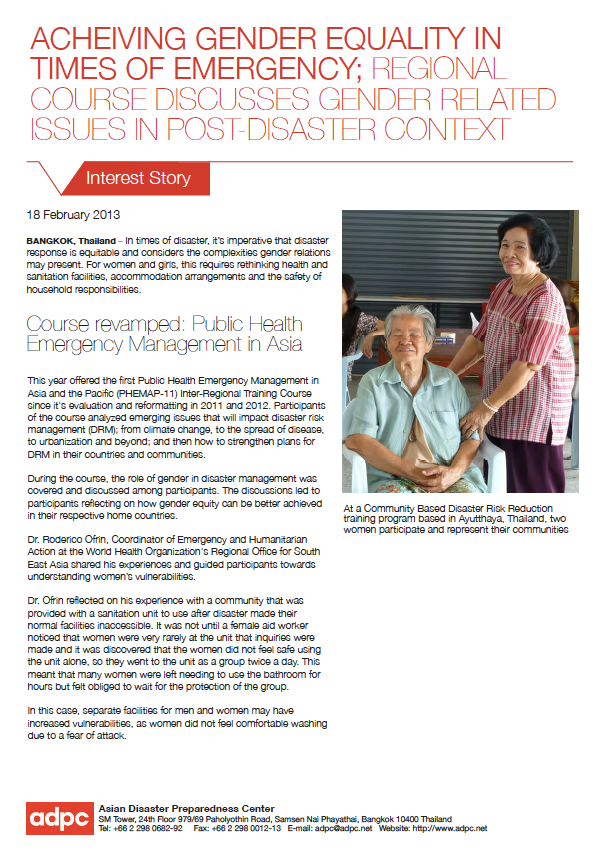- About Us
-
Who we are
-
- Publications
-
- ADPC Academy
-
MediaADPC'S NEWS
Training course offers officials an opportunity to share experiences and exchange ideas Training course offers officials an opportunity to share experiences and exchange ideas
22 May 2013
Bangkok, Thailand
This June, government authorities will join in a training course to explore ways to mainstream disaster risk reduction (DRR) and climate change adaptation (CCA) into development processes at the national and sub-national levels.
The course, Mainstreaming Disaster Risk Reduction into Development, aims to cultivate a thorough understanding of the link between disasters and development and provide guidance on how DRR can be incorporated into national and local development planning and implementation frameworks. This begins by identifying ‘entry points’ for integrating DRR into development processes; and targets capacity building to mainstream DRR at the national and sub-national level and across all sectors.
Sponsored by the Australian Agency for International Development, AusAID, the five-day training course is facilitated by Asian Disaster Preparedness Center (ADPC). The course is currently in its 4th consecutive run.
"Mainstreaming disaster risk reduction is ultimately about partnership and collaboration between different institutions. This training is very practical because it goes beyond the concept and brings planning practitioners and NDMOs together. They identify challenges and find solutions together. We hope ADPC offers this training program to more countries and promotes political support to these practical actions,"
Mr. Yongkyun Kim, Institute Coordinator in the UN ISDR Office at Incheon commented.Ms. Thitiphon Sinsupan, Project Manager, Disaster Risk Management Systems Department, ADPC, encourages participants to share their ideas regarding mainstreaming DRR into development
Photo by: Pannawadee SomboonGovernment officials and development partners from countries around the region will undergo the training course from 10-14 June 2013 to learn ways in which they can ensure measures to reduce and manage disaster risk becomes an integral component of the development planning process. Ms. Lissa Giurissevich, Senior Program Officer from AusAID remarked on the 2012 course, “Participation demonstrates governments’ dedication to minimizing the impacts of disasters. Officials have the opportunity to brainstorm on how to ensure their development activities are more disaster resilient.”
Cross-cutting nature of DRR, ‘a challenge’
From planning and resource allocation to project design and implementation, agriculture to education, DRR cuts across just about every sector and stage of the development planning process. Previous participants have agreed that addressing the cross-cutting nature of DRR is a major challenge. This year’s participants will continue to tackle this during the 5-day session.
"DRR is cross cutting and in some countries this results in no one taking responsibility for it. This is the case in Pakistan for example,"
Mr. Irfan Maqbool, Department Head, Safer Development Planning and Implementation Department, ADPC commented.Planning into process – the power of political will
Although the need to mainstream DRR into national development processes is a priority for all throughout the region, putting policy into practice is said to be at the will of national and local governments. 2012’s participants agreed that the success of mainstreaming DRR into national development processes begins with political will. Without government endorsement, advocacy at the community level becomes difficult for some countries. Others, with a stronger civil society, such as with the case of Bangladesh, act as best practice cases in which the region can learn from.
"In Bangladesh, the political will is there. You can see everyone’s commitment to mainstreaming Disaster Risk Reduction (DRR) at all levels. Communities are vibrant and know the advantage of a proactive approach to mainstreaming DRR in their planning and development project implementation,"
explains Mr. Naseer Iqbal, International Programs Specialist for Qatar-based Reach Out to Asia (ROTA), a non-profit organization based in Qatar providing high quality primary and secondary education, creating safe learning environments and restoring education in crisis affected areas across Asia and the Middle East.“Successful disaster risk management requires thinking outside the box. Having a proactive, not reactive, approach to issues such as climate change and disaster management needs a broader understanding within the political and social setup,” Naseer continued.Mr. Naseer Iqbal, International Programs Specialist for Qatar-based Reach Out to Asia (ROTA), brainstorms ideas about how better to include DRR in national and local development planning.
Photo by: Pannawadee SomboonAdvocacy – the key to success at all levels
At the end of the training session, participants are urged to return to their home countries and re-ignite the advocacy process on DRR mainstreaming with their respective ministries and become champions for the implementation of mainstreaming initiatives in their countries.
“After returning home, we hope that knowledge gained here will be transferred at the national and sub-national levels,”
Ms. Giurissevich commented.Related PublicationsLatest NewsRelated Trainings
-

